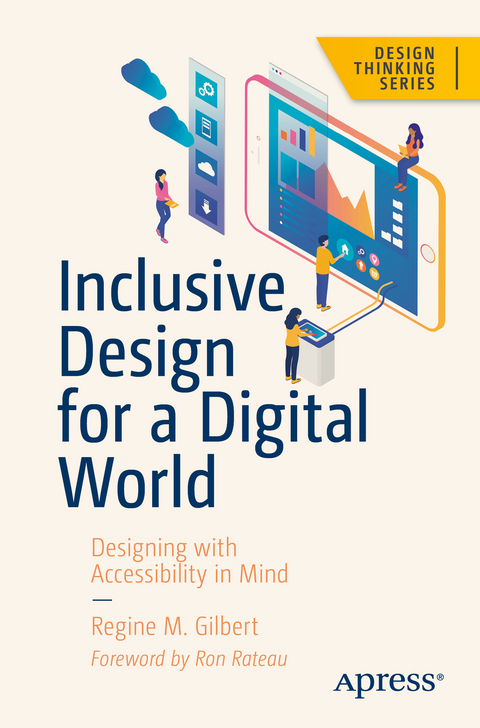
Inclusive Design for a Digital World
Apress (Verlag)
978-1-4842-5015-0 (ISBN)
In Inclusive Design for a Digital World, multiple crucial aspects of technological accessibility are confronted, followed by step-by-step solutions from User Experience Design professor and author Regine Gilbert. Think about every potential user who could be using your product. Could they be visually impaired? Have limited motor skills? Be deaf or hard of hearing? This book addresses a plethora of web accessibility issues that people with disabilities face. Your app might be blocking out an entire sector of the population without you ever intending or realizing it. For example, is your instructional text full of animated words and Emoji icons? This makes it difficult for a user with vision impairment to use an assistive reading device, such as a speech synthesizer, along with your app correctly. In Inclusive Design for a Digital World, Gilbert covers the Web Content Accessibility Guidelines (WCAG) 2.1 requirements, emerging technologies such as VR and AR, best practices for web development, and more.
As a creator in the modern digital era, your aim should be to make products that are inclusive of all people. Technology has, overall, increased connection and information equality around the world. To continue its impact, access and usability of such technology must be madea priority, and there is no better place to get started than Inclusive Design for a Digital World.
What You’ll Learn
The moral, ethical, and high level legal reasons for accessible design
Tools and best practices for user research and web developers
The different types of designs for disabilities on various platforms
Familiarize yourself with web compliance guidelines
Test products and usability best practices
Understand past innovations and future opportunities for continued improvement
Who This Book Is For
Practitioners of product design, product development, content, and design can benefit from this book.
Regine Gilbert is a user experience designer, educator, and international public speaker with over 10 years of experience working in the technology arena. Her passion for accessibility stems from growing up with family who were disabled. Since working in technology she has spearheaded accessibility initiatives within the organizations in which she worked including creation of guidelines and training. She has a strong belief in making the world a more accessible place—one that starts and ends with the user. Regine is an Adjunct Professor at NYU Tandon School of Engineering, teaching User Experience Design to students in the Integrated Digital Media Program. In addition, she teaches the part time User Experience Design course at General Assembly. Some of the companies Regine has had the pleasure of working for include Disney, JP Morgan, Four Seasons Hotel and Resorts, Ralph Lauren, Columbia University and Vitamin Shoppe.
Chapter 1. Designing with Accessibility in Mind.- Chapter 2. Accessibility, Content, HTML, JavaScript, CSS and the Land of Accessible Rich Internet Applications.- Chapter 3. If It’s Annoying, It’s Probably not Accessible.- Chapter 4. Compliance and Accessibility.- Chapter 5. Building a Vision for the Future: Design Strategies for Accessibility.- Chapter 6. Inclusive Design Research.- Chapter 7. Assistive Technologies.- Chapter 8. Planning and Implementing Inclusive Designs.- Chapter 9. Usability Testing.- Chapter 10: Beyond the Web.
“I would be comfortable recommending that student team members purchase a copy. I believe it offers a good combination of background information on inclusive design, practical advice for dealing with common interaction limitations, and pointers to additional resources.” (Franz Kurfess, Computing Reviews, September 7, 2021)
| Erscheinungsdatum | 30.12.2019 |
|---|---|
| Reihe/Serie | Design Thinking |
| Zusatzinfo | 72 Illustrations, color; 18 Illustrations, black and white; XXVI, 272 p. 90 illus., 72 illus. in color. |
| Verlagsort | Berkley |
| Sprache | englisch |
| Maße | 155 x 235 mm |
| Themenwelt | Kunst / Musik / Theater ► Design / Innenarchitektur / Mode |
| Mathematik / Informatik ► Informatik ► Grafik / Design | |
| Mathematik / Informatik ► Informatik ► Software Entwicklung | |
| Schlagworte | Accessibility • Accessibility and Inclusive Design • accessible design • Benefits of Accessibility • Coding Accessibility • Color Contrast • Content for accessibilty • inclusive design • Planning Accessible Design • Tools for accessibility • Usability and Accessibility • User Research |
| ISBN-10 | 1-4842-5015-X / 148425015X |
| ISBN-13 | 978-1-4842-5015-0 / 9781484250150 |
| Zustand | Neuware |
| Haben Sie eine Frage zum Produkt? |
aus dem Bereich


